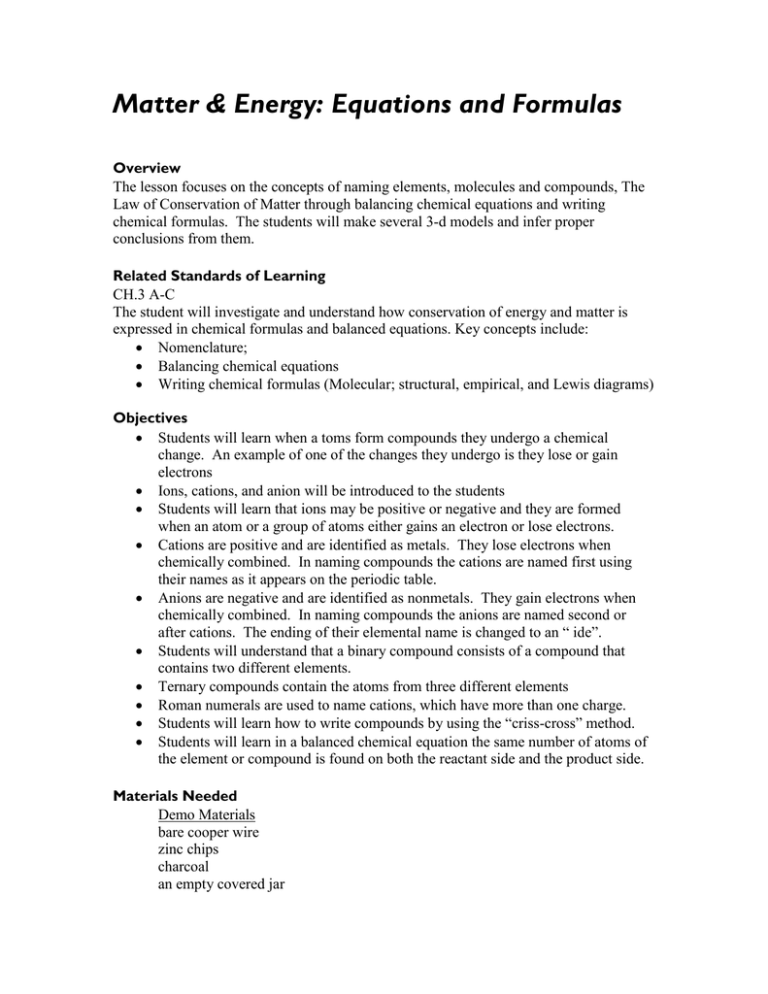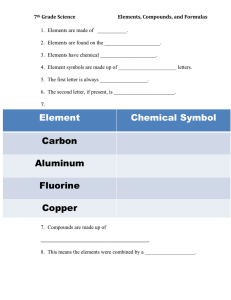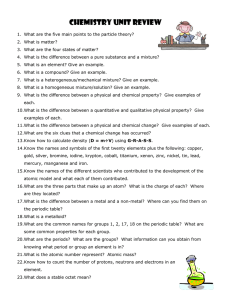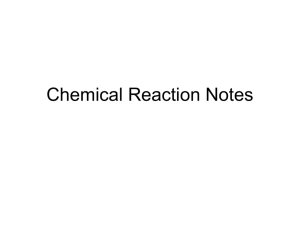Matter & Energy: Equations and Formulas
advertisement

Matter & Energy: Equations and Formulas Overview The lesson focuses on the concepts of naming elements, molecules and compounds, The Law of Conservation of Matter through balancing chemical equations and writing chemical formulas. The students will make several 3-d models and infer proper conclusions from them. Related Standards of Learning CH.3 A-C The student will investigate and understand how conservation of energy and matter is expressed in chemical formulas and balanced equations. Key concepts include: Nomenclature; Balancing chemical equations Writing chemical formulas (Molecular; structural, empirical, and Lewis diagrams) Objectives Students will learn when a toms form compounds they undergo a chemical change. An example of one of the changes they undergo is they lose or gain electrons Ions, cations, and anion will be introduced to the students Students will learn that ions may be positive or negative and they are formed when an atom or a group of atoms either gains an electron or lose electrons. Cations are positive and are identified as metals. They lose electrons when chemically combined. In naming compounds the cations are named first using their names as it appears on the periodic table. Anions are negative and are identified as nonmetals. They gain electrons when chemically combined. In naming compounds the anions are named second or after cations. The ending of their elemental name is changed to an “ ide”. Students will understand that a binary compound consists of a compound that contains two different elements. Ternary compounds contain the atoms from three different elements Roman numerals are used to name cations, which have more than one charge. Students will learn how to write compounds by using the “criss-cross” method. Students will learn in a balanced chemical equation the same number of atoms of the element or compound is found on both the reactant side and the product side. Materials Needed Demo Materials bare cooper wire zinc chips charcoal an empty covered jar a beaker of the compound water __________________________ 250 mL beaker 250 mL flask White vinegar Steel wool Balloon Balance Periodic Tables Lab Materials per group Solution of NaOH Solution of CuSO4 Solution of NH4OH Solution of Zn(NO3)2 Four 3 oz. plastic cups Three 5 oz. plastic cups Balance Graduated cylinder -----------------------------four pipe cleaners one large plastic foam ball four small plastic foam balls metric ruler protractor Instructional Activity Content, Teacher Notes a) This lesson takes 4-90 blocks b) For complete understanding of modern chemical nomenclature the students must be familiar with the following terms: Ions molecule chemical formula Cation molecular compounds molecular formula Anion ionic compounds formula unit Binary ternary polyatomic ions c) The concept of empirical formulas can be introduced on day four however, really should be taught after introducing the mole. Introduction Nomenclature 1. Display samples of common elements (e.g., bare cooper wire, zinc chips, charcoal), an empty covered jar to represent diatomic molecules of oxygen gas and nitrogen gas (which comprise 99% of the air we breathe), and a beaker of the compound water. 2. Using each of the above example, together with the students come up with a working definitions of element, molecule and compound An element is any substance that cannot be split into simpler substance by ordinary chemical means. A molecule is a particle that has to or more atoms bonded together. A compound is a molecule with different kinds of atoms. 3. Distribute copies of the Periodic Table of the Elements. 4. Point out the 7 diatomic elements( H, N, C, O F, Cl, Br). 5. Explain the rules for writing symbols and formulas to students. a) Writing basic ionic compound formulas. i. Ionic compounds: usually contain a metal and a nonmetal. ii. Use charges to write the formula. iii. If it is a transition metal, the Roman numeral gives the charge. iv. Notice the -ide ending. This tells you that it is a single element, not a polyatomic ion b) Using Polyatomic Ions in ionic compounds. i. Each polyatomic ion is a complete unit, NEVER break it up or change the numbers. ii. Use charges just like with regular ionic compounds. iii. Most end in -ate and -ite, only a few (cyanide, hydroxide) have an -ide ending. a) Writing formulas for molecular compounds. iv. Molecular compounds: nonmetals only! v. DO NOT USE CHARGES!!! vi. Prefixes give the number of each element. vii. Writing names for compounds . viii. CHECK IF IT IS IONIC OR MOLECULAR!! ix. If it is molecular, see II above. x. If it is ionic, name the first element, then name the second ion. If it is a single element, then just change the ending to an -ide. If it is more than one element, it is a polyatomic ion (one you have memorized)!! Use the name you memorized. xi. Check if the metal is a transition metal. If it is, you need a Roman numeral. When writing the names for these compounds you need to figure the charge by working backwards. xii. Example: FeCl2 would be iron chloride, until you noticed that iron is a transition metal. To figure the charge, first find the charge of the negative ion (chloride). It is Cl-1. Since there are 2 of these chlorides given in the formula FeCl2, the total negative charge is -2. Therefore the iron must be a +2 to offset it. The final name is iron (II) chloride. xiii. Example: PtO2, O has a -2 charge, there are two of them, so the total negative charge is -4. Therefore platinum (Pt) must be +4. The final name is platinum (IV) oxide. xiv. Example: Fe2O3, O has a -2 charge, there are three of them, so the total negative charge is -6. The total positive charge must be +6, since there are 2 irons (Fe), then each Fe must have a charge of +3. The final name is iron (III) oxide. 6. Assist students in writing the chemical symbols of elements and the chemical formulas for molecules and compounds. Procedure Balancing chemical equations Begin class with the following demo that will get your students thinking about the Law of Conservation of Matter. Note: In this demo, the iron in the steel wool rapidly oxidizes (rusts) to form iron (III) oxide. The result is a rusty piece of steel wool and a balloon that has been completely sucked into the flask. However, the mass both before and after the reaction is the same. This should provide you with a nice hook to begin a discussion on the Law of Conservation of Matter. 1. Tear off an egg sized piece of steel wool. Be careful not to ball it up too tightly. 2. Place the steel wool into the 250 mL beaker and add white vinegar until the entire piece of steel wool is immersed. Soak for 4-7 minutes. 3. Remove the steel wool from the vinegar and wring out any excess vinegar. 4. Place the steel wool into the 250 mL flask and cover the opening of the flask with a balloon. 5. Mass the entire steel wool-balloon-flask system and record. 6. Allow this system to sit for 30-45 minutes. 7. Later, observe the results and again take the mass of the steel wool-balloon-flask system and record. You will notice that this exercise also stresses balancing chemical equations. Provide students with the unbalanced version of the chemical equation below and have them practice this skill prior to proceeding to the main portion of the activity. 4 Fe (s) + 3 O2 (g) --------> 2 Fe2O3 (s) Lab: Balance Equations Solution Preparation 1. If your school does not have sodium hydroxide, then it can be obtained from Drano or Red Devil Lye. If you use Drano, the solution does not need to be very concentrated but you would want to filter the aluminum filings that are mixed in with the pellets of NaOH. Lye is CAUSTIC so wear gloves and wash all surfaces anyone might touch. Also be careful with sodium hydroxide pellets. They will absorb water from the air to create a concentrated drop that will burn through most fabrics. 2. If your school does not have copper (II) sulfate, then it can be purchased at a good hardware store as an algaecide (Bluestone) or root eater. Solutions can be prepared directly and since this is a precipitate reaction, the concentrations are qualitative and approximate. 3. Ammonium hydroxide is nothing more than household ammonia. Use it straight out of the bottle from the grocery store. 4. The only chemical that may be difficult for you to find is the zinc nitrate. Probably the easiest thing to do would be to borrow some from the high school that your school feeds into. You will need 20 to 30 g of it. 5. Again the concentrations are not critical. This lab was tested with all solutions at 0.1 M concentration except the ammonia. Below are the recipes for making a liter of 0.1 M solution for each of the solutions in this lab except ammonium hydroxide. 22 g CuSO4 into 1 liter 4 g of NaOH into 1 liter 24 g of Zn(NO3)2 x 3H2O into 1 liter or 30 g of Zn(NO3)2 x 6H2O into 1 liter Safety Precautions 1. As mentioned in the solutions preparations section, sodium hydroxide is CAUSTIC and should be handled carefully. Students may need to wear gloves. The base will feel slippery on the skin (just like soap) and should be washed immediately. 2. Copper solutions can cause eye infections, so students should wash their hands after handling these substances, too. Procedure 1. Measure 60 mL of NaOH solution in a graduated cylinder and then pour into a small (3 oz) clean plastic cup. 2. Rinse the graduated cylinder completely before making the next measurement. 3. Measure 60 mL of CuSO4 solution in the graduated cylinder and then pour it into a clean 5 oz cup. 4. Carefully place the two solutions on the balance, making sure the solutions do not mix. Mass the solutions and the cups together and record the combined mass. 5. Pour the NaOH into the 5 oz cup with the CuSO4 solution. Allow the solutions to mix. Record your observations. 6. Mass both cups and the mixture again. Record the new mass. By how much did the mass change? 7. Repeat the process in steps 1-4 above for the combinations listed in the data section below. Do not allow the solutions to mix before taking the initial mass. Reaction Mass (g) Before Mass (g) After Observations NaOH and CuSO4 NH4OH and CuSO4 NH4OH and Zn(NO3)2 Complete the following equations and balance: 1. ___ NaOH + ___ CuSO4 -----> _____________________________________________ 2. ___ NH4OH + ___ CuSO4 -----> ____________________________________________ 3. ___ NH4OH + ___ Zn(NO3)2 -----> __________________________________________ Equations: 1. 2NaOH + CuSO4 -----> Na2SO4 + Cu(OH)2¯ 2. 2NH4OH + CuSO4 -----> (NH4)2SO4 + Cu(OH)2¯ 3. NH4OH + Zn(NO3)2 -----> NH4NO3 + Zn(OH)2¯ Writing chemical formulas (molecular; structural; empirical) Chemistry Geometrics In this activity, students will create models of molecules that have different molecular shapes. Students will be able to write molecular and create structural formals of several compounds. Procedure: 1. Stick one pipe cleaner into each of the small plastic foam balls. 2. Take two of the small plastic foam balls and stick the other end of the pipe cleaners into the large plastic foam ball so that the two small balls are as far apart from each other as possible. 3. Have student note the shape of this model. 4. Use the protractor to measure the angle between the large ball and the two small balls. Record this value in the data table. 5. Detach the small ball from the model. Now attach three small balls to the large ball so that the three balls are as far apart from each other as possible. Not the shape of this model. 6. Measure the angle between two of the small balls. Since the balls should be as far apart from each other as possible, the angles between all of the balls should be the same. Record this measurement in the data table. 7. Repeat steps 4 and 5 using four small balls. 8. Have students record the data: Independent Variable- number of balls Dependent Variable: Angle between small balls 9. On three separate sheets of paper, have the students then sketch the three models they created in the activity and come up with a name for each. Names: Linear, Triagonal, and Tetrahedral 10. Under each sketch describe the relationship between the number of atoms in a molecule and the size of the angles between the bonds in the molecule. The greater the number of atoms, the smaller the angle between atoms 11. Begin a discussion on why they think that atoms arrange themselves in molecules so that they are as far apart from each other as possible. 12. Students should suggest that the electron clouds around atoms repel each other, thus forcing them apart to the greatest degree. Stress the fact that the valance electrons determine reactivity for forming molecules and compounds. 13. At this point review valance electrons, oxidation states and introduce the crisscross method for writing molecular formulas. 14. Before the end of this lesson, introduce the concept of empirical formulas, by giving the definition, showing some examples and comparing the difference between empirical and molecular formulas. Tell students that this is just a taste of what is to come. In the next couple of weeks after they know what a mole is, than they will be able to calculate the empirical formula. This should insight their curiosity about the mole……keep them wondering! Conclusions 1. Why is it important to balance a chemical reaction? balanced chemical equations obey the Law of Conservation of Matter and thus are true representations of what actually occurs in nature. 2. Why do you think that atoms arrange themselves in molecules so that they are as far apart from each other as possible? electron clouds around atoms repel each other 3. Have them list the four different ways to chemists use “short hand” to write chemical formulas. (Molecular; structural, empirical, and Lewis diagrams). Students may forget Lewis dot because it was introduced in a previous lesson, but use this as reinforcement. By the end of this lesson the student will be able to: Use proper nomenclature; Balancing chemical equations And writing chemical formulas Sample Assessment 1. Which is always named first, when naming an ionic compound? A B C anion hydrogen atom the element that has a greater mass D cation 2. Which of the following formulas represents anhydrous copper (II) sulfate? A Cu2SO4 . 5H2O B Cu(SO4) 2 C CuSO4 D Cu(SO4) 2 . 5H2O 3. Ferric oxide is the same as which compound? A iron (I) oxide B iron (II) oxide C iron (III) oxide D iron (IV) oxide 4. Which is a balanced equation for the following reaction? tin + oxygen tin (IV) oxide A B C D Sn + O SnO Sn + O2 SnO2 2Sn + 2O SnO2 2Sn + O2 2SnO Potenti al Energy 5. Which of the following is NOT an empirical formula? A B C D H2O2 HCl H2O MgI2 6. Name the following compound: CuO. A copper (I) oxide B copper (II) oxide C copper (III) oxide D copper (IV) oxide 7. In order to balance the following equation, which coefficient would need to be placed in front of SO2? __ SO2(g) + O2(g) + 2H2O(l) 2H2SO4(l) A B 1 2 C 3 D 4 8. The chemical formula for sulfur difluoride would be: A B C D S2F. S2F2. SF2. SF. 9. Which of the following Lewis dot diagrams is NOT a bent molecular shape? A B C D .. x x .. . x F x S x .. . . x . . F. .. .. .. .. I x . .. . x x xO. I . x x .. .. x x .. x O .. x N .. . x .. Cl .. .. . . . .. . Cl . .. .. Cl x. Six x. I .. .. . x . . .. . Cl . .. 10. Which of the following equations is NOT balanced? A B C D Na2O + H2O 2NaOH CaO + H2O Ca(OH)2 2K + Cl2 2KCl Al + HCl AlCl3 + H2 11. Which of the following may represent an empirical formula? A C4H10O B C5H10O2 C C6H6 D NH2CH2COOH Al2(SO4)3 + Ca(OH)2 Al(OH)3 + CaSO4 12. In order to balance the equation, the following coefficients would need to be added: A B C D 13. 1,3,3,2 2,3,3,1 1,3,2,3 1,1,3,2 Consider the following unbalanced equation. What three coefficients need to be added to balance this equation? heat mercuric oxide mercury + oxygen heat HgO Hg + O2 A B C D 1,2,1 2,2,2 1,1,1 2,2,1 14. 100 grams of nitrogen will unite with 114 grams of oxygen to form an unknown compound. This data can be used to determine: A the structural formula. B the Lewis dot diagram. C the empirical formula. D the molecular formula. 15. What is the most precise and accurate name for this substance? NO A B C D 16. mono-nitrogen oxide mono-nitrogen monoxide nitrogen monoxide nitrogen oxide Consider the following equations. Which is balanced correctly? A B C H2 + 2O2 H2O 2H2 + O2 2H2O 2Na + 2O2 2Na2O D 2Al + 3O2 Al2O3 17. Which of the structural formulas below represents a methane molecule? A H H C H H B H H C C H H H H H C C C H H H H H H H C C C C H H H H H C H D H H H 18. CuCl2 is the formula for what? A copper (II) chloride B copper chloride C cupric chloride D copper monochloride H 19. What is the chemical name for the compound having the formula CaSO4? A B C D calcium hydroxide calcium sulfite calcium sulfate calcium oxide 20. What is this chemical structure called? A B C D a benzene ring a cycloalkane a hexane circle a bucky ball Follow-up/Extension Have students invent their own board game on the concepts of nomenclature, balancing equations or writing chemical formulas. Resources Rules for Writing Chemical Formulas and Compounds http://www.fordhamprep.org/gcurran/sho/sho/lessons/lesson53.htm Balancing Equation Tutor http://www.wfu.edu/~ylwong/balanceeq/balanceq.html Home




